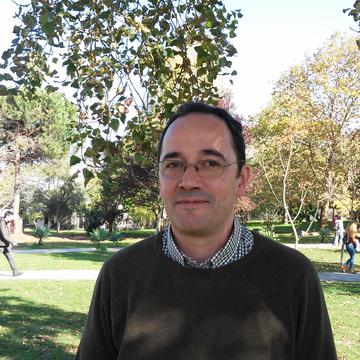
Member of the Associated Laboratory for Green Chemistry - Clean Technologies and Processes
Specialized in molecular photophysics and photochemistry, time-resolved and steady state absorption and emission spectroscopy. Research interests in photochemical sensors and actuators, light energy conversion, photo-oxidation, DSSC’s, stimuli controled molecular assembly and rehology.
ORCID Researcher ID Scopus Author ID
![]()
Research higlights
Reversible aurophylic self-assembly

We describe new gold(I) complexes that self-assemble through different intermolecular interactions:(i) chain assemblies, which are based mainly on aurophilic interactions, and (ii) stacked assemblies, which are based on Au···π and π···π interactions. The compounds were designed to disassemble the aggregates in the presence of Zn2+, while sequestration of Zn2+ revert the process to the aggregation stage. The adaptive nature of the supramolecular assemblies to the metal-ion content is accompanied by significant changes in the absorption and emission spectra, signaling the aggregation state and also the content on Zn2+.
Phocatalysis with activated carbon

The use of carbon materials as additives and supports to semiconductors has been long explored and many studies have shown that adding a carbonaceous phase in the catalyst provides a superior performance.Our recent investigations have also proved the photoactivity of semiconductor-free carbons under UV light and their ability to photogenerate O-radicals. Using monochromatic light we have shown the ability of semiconductor-free nanoporous carbons to convert the low energy photons from the visible spectrum in chemical reactions (i.e. phenol photooxidation). The onset wavelength of the photochemical activity can be tuned upon surface functionalization, with enhanced visible light conversion upon introducing N-containing groups (red shift).
Light Control of transcription

From André Vidal Pinheiro PhD thesis & Nucleic Acids Research, 2008, 36, 14, e90
We describe the use of ATP caged with [7-(diethylamino)coumarin-4-yl]methyl (DEACM) for light-controlled in vitro transcription reactions. Polymerization is blocked when DEACM is bonded to the gamma phosphate group of the ATP molecule. Controlled light irradiation releases ATP and transcription is initiated. Our data provide the first direct evidence of control over enzymatic polymerization of nucleic acids through light.
Fluorophores and gold nanoparticles

From João Rosa PhD thesis & Nanotechnology, 2011, 22, 415202
We describe a method to measure quantum yields of fluorophores in the presence of gold nanoparticles exploring charge repulsion. We propose an experimental-based tool for dealing with fluorescence modulation close to nanoparticles for application in studies of fluorophores in the vicinity of gold nanoparticles (AuNPs), typically addressed via theoretical models.
Photorehological Ionic Liquids

From João Avó PhD thesis & Org. Lett., 2014, 16 (10), pp 2582–2585
We describe two ionic liquids with photoisomerizable p-hydroxycinnamic acid moieties were synthesized and characterized by X-ray crystallography and DSC, and their photochemistry was studied in solution and neat conditions. Irradiation at absorption maxima led to trans–cis photoisomerization and resulted in significant reduction of melting temperatures of the ionic liquids.
Spectral codification trough energy transfer

From Letícia Giestas PhD thesis & Sensors and Actuators B: Chemical, 2008, 134(1), 146-157.
We describe the use of multiple donors for FRET-based SNP detections through their application to the spectral codification for the simultaneous detection of different DNA sequence targets in a single vial. The use of multiple donors in the same DNA chip generates several layers of information on a DNA chip increasing the number of DNA target sequences that can be screened, thereby reducing the time and cost of identifying SNPs.
Luminescent membranes for sensing

Sérgio Santoro et al. Journal of Membrane Science, 2016, 514: 467-475.
We describe the introduction of photochemical activity in membranes that opens a new perspective for non-invasive monitoring of membrane processes (e.g. measurement of temperature in membrane distillation processes, oxygen measurement for monitoring of biofilm onset and development in reverse osmosis).
![]()
Past PhD work supervisions
"Monitoring of the structural alterations induced during ultrafiltration processes using fluorescence techniques" , Carla Portugal, 2006
“Fluorescent resonance energy transfer based systems for molecular codification", Letícia Giestas, 2009
“Light Controlled Synthesis of Nucleic Acids”, André Vidal Pinheiro, 2010
"Characterization of sol-gel matrices with imobilized cutinase", Gustavo Barreira, 2012
“Nanobiophotonics for molecular diagnostics", João Rosa, 2013
“Photochemical control of rheology”, João Avó, 2014
“Oxygen Transport enhancement by functionalized magnetic nanoparticles (FMP) in bioprocesses”, Filipe Ataíde, 2016
Ongoing PhD work supervisions
Milton Cordeiro "Gold NanoBeacons for Spectral Codification – application as a DNA sensor"
David Sousa "Semiconductor nanoparticles for energy conversion"
Mani Hosseinzadeh "Enhancement of Luminescence Properties of Cu(I) based Materials"
PhD work supervision in photochemistry of external students (secondments)
"Oxidative Photodegradation of phenol withe TiO2-C catalysts. Analysis of the photochemical response of the carbonaceous phase",Letícia Velasques, 2012
" Photochemical response of nanoporous carbons. Role as catalysts, photoelectrodes and additives to semiconductors", Alicia Berenger, 2016
"Molecular probes: an innovative technology for monitoring membrane processes", Sergio Santoro, 2016
![]()
Ongoing projects
Harvesting and storage of solar energy - Foundation for Science and Technology - SAICTPAC/0046/2015
Dye Sensitized Solar Cells based on ionic liquids and synthetic flavylium compounds - Foundation for Science and Technology - PTDC/QEQ-QFI/1971/2014
Supra- and nanostructured systems for molecular recognition in water - Spanish Ministry of Economy and Competivity
Past projects
2012-16 European project NMP4--‐SL2012--‐310651 under FP7--‐NMP--‐2012--‐SMALL--‐6 “SACS–Self-Assembly In Confined Space”
2012-15 PTDC/QUI-QUI/117996/2010 BIOPAD - Bio-Inspired Synthesis Of A New Palette Of Anthocyanin Derivatives
2011-15 COST action no. CM1005 Supramolecular Chemistry in Water
2011-14 PTDC/QUI-QUI/112597/2009 – NANOLIGHT - Nanosystems for delivery of caged compounds
2009-12 PTDC/QUI/64744/2006 Sol-gel entrapped cutinase: Understanding enzyme/matrix interactions via fluorescence, NMR and DRIFT spectroscopies, and site-directed mutagenesis
2009-12 PTDC/QUI/65728/2006 Anthocyanins as Natural Photoprotectors
2008-11 PTDC/QUI/67786/2006 CHROMOGENICS: Study and Characterization of Chromogenic Materials
2005-09 COST Action D31 Organising Non-Covalent Chemical Systems with Selected Functions; Internal Project N. D31/0016/05 Non-Covalent Interactions Between Functional Abiotic Receptors and Ion Pairs and Internal Project N. D31/0011/04 Supra-Biomimetics: Towards Bio-Inspired Photoadressable Supramolecular Systems. Synthesis, Light-Emission, Dynamics, Biomedical Applications
2005-06 POCTI/QUI/57735/2004, Photochromism of flavylium compounds in water/ionic liquid biphasic systems
2003-06 POCTI/QUI/45141/2002 Nanostructures of noble metals in organized media: towards tecnhological application
2003-06 POCTI/QUI/47357/2002, Chemosensors Based on Fluorescent Poliamine Receptors
2003-06 POCTI/BIO/38922/2001, Randomly ordered DNA sensors based on direct questioning of immobilised probes with wavelength shifting pairs
2001-04 POCTI/QUI/33679/99 – Photophysics and Photochemistry of anthocyanins
![]()